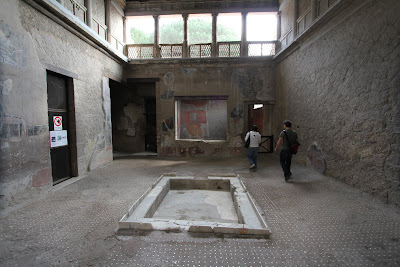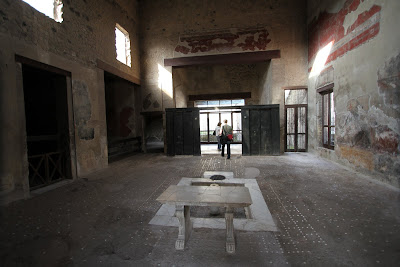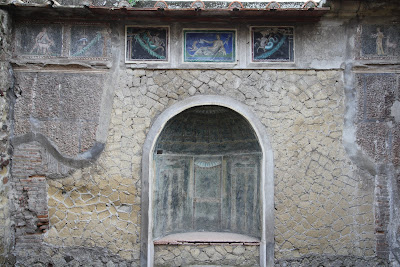
Getting There
On the way to Ercolano (from Cuma) we missed the lane to stay on the elevated highway (ss162dir) in Naples and ended up on surface streets. It was pure chaos. There was a traffic jam, the unfortunate piles of trash, and people going every which way. We follow the lead of other drivers and drive down the center lane reserved for the tram to break free and pick up the freeway we missed. Phew, Travelmarx have earned their honorary Naples driving license. But alas we were too cocky, because in Herculaneum we drove through the Sunday market - not a smooth move. We heard a couple of 'Francese' hurled our way – we did have French plates on the car. Mais oui! After asking for directions several times (we are getting over that fear because the locals give better directions than the GPS for that last 1 km) we arrive a little frazzled but otherwise intact at Scavi di Ercolano. Hint: there is no official parking lot for the ruins as far as we could tell. Here is where we parked and it was close, reasonable and near a police station to boot.
Visiting the Ruins
After the adventure of getting there, in we went to the ruins. You actually walk down a large walkway (one side of a public garden) to get to the ticket office. After purchasing tickets we immediately bumped into a woman who offered guide services. We got her credentials and felt comfortable with her and said yes. Her name is Concetta Mennella (conny.green@hotmail.com) and she works for http://www.guidenapoli2000.com/ (Tel: 081 808 34 14, Tel: 339 788 46 14 - Concetta). She has a background in volcanism and archaeology. We highly recommend her! We asked her to speak in Italian and use English if needed and she obliged readily. It's a great two hour tour. She’s passionate about Ercolano and sharing it with visitors. Bonus is that she gave us two cachi (persimmons) from her dad’s garden. We explore several more hours after the paid tour.
Herculaneum is simply fascinating. We visited Pompeii years ago and remembered being awed, but, Herculaneum is different because it is more compact and the modern city closes in on it so tightly. Standing in the midst of the ruins and staring up the modern city boggles the mind. And, only 25% of Ercolano is estimated to be uncovered: 4.5 hectares of an estimated 20 hectares are exposed. Will the rest of the ancient city ever be uncovered? It would be a truly Herculean (the city’s mythical namesake) effort according to Concetta, our guide. The cost to relocate residents would be astronomical. When you look up to the modern city perched at the edge - you might agree with her.
Herculaneum like its sister city Pompeii was devastated by the Vesuvius eruption of 79 AD. Herculaneum was devastated in a different way in that it was covered by a pyroclastic flow that covered the city to an average depth of 48 feet and solidified while Pompeii was primarily covered by ash and pumice. The pyroclastic rock and intense heat at Herculaneum preserved items in situ like wood doors (through the process of carbonization), ornately decorated walls, machinery, vases, bed frames, and bodies. Some 300+ bodies were found at the boathouses in 1981. These were the unfortunate people who couldn't escape or were waiting to escape. (The population is estimated to be about 4,000 in this wealthy town, so most got away.) The experts say death was quick for the people huddled in the boathouses but their poses indicate otherwise. The boathouses were at one time at the edge of promontory on the sea but now the sea is a few kilometers away to the west. In fact, to keep Herculaneum from flooding there is continuous pumping out of water.
The Herculaneum site is part of the UNESCO site designation covering Pompeii, Herculaneum and Torre Annuziata because they “provide a complete and vivid picture of society and daily life at a specific moment in the past that is without parallel anywhere in the world.” To visit the snapshot of life 1900+ years ago, there are many possible guide books. There is a small booklet and foldout map you get when you get your tickets that are handy. Examples are attached to this entry.
There were many aspects of Herculaneum that we didn’t see because we just missed them or they were closed. One that was closed (we are almost certain or else our guide would have mentioned it) was Villa dei Papiri. I guess we’ll have to settle on having seen the reproduction at the Getty Villa and leave it as an option for next time were are in the area.
No 1, Barrel Arches (Fornici)

No 2, Terrace of M. Nonius Balbus (Terrazza di M. Nonio Balbo)

No 3, Suburban Baths (Terme Suburbane)

No 7, House of Relief of Telphus (Casa del Rilievo di Telefo)

No 7, House of Relief of Telphus – Relief (Casa del Rilievo di Telefo)

No 8, House of the Deer (Casa dei Cervi)

No 10, Large Taberna (Grande Taberna)

No 12, Palaestra (Palestra)

No 16, House of the Corinthian Atrium (Casa dell’Atrio Corinzo)

No 18, House of the Black Room (Casa del Salone Nero)

No 22, Thermoplium

No 24, Siège des Agustaux (Sede degli Augustali)

No 27, Women's Bath (Terme Femminili)

No 28, House of the Beautiful Courtyard (Casa del Bel Cortile)

No 29, House of Neptune and Amphitrite (Casa di Nettuno e Anfitrite)

No 30, Bottega

No 31, Samnite House (Casa Sannitica)

No 31, Samnite House - with children's graffiti

No 34, House of the Bronze Herm (Casa dell'Erma di Bronzo)

No 36, House of the Wooden Partition (Casa del Tramezzo di Legno)

No 37, Lanarius Shop with Clothes Press (Bottega del Lanarius)

No 40, House of Argus (Casa d'Argo)

No 42, House of the Skeleton (Caso dello Scheletro)

Herculaneum Guide Book Example Page

Herculaneum Guide Book Cover

Carbonized Boat

Herculaneum Brochure Front

Herculaneum Brochure Back

No comments:
Post a Comment
All comments are moderated. If your comment doesn't appear right away, it was likely accepted. Check back in a day if you asked a question.